April 2016
Guest Editorial tonight - The Katy into Lincoln!
Apr 26, 2016 Filed in: Prototype Research

Not really an editorial, but a link to a great article that I found on the interwebtubes, about the Missouri Pacific at Lincoln, Nebraska.
I was doing some online research about MKT's "Siberian Subdivision", which is what the Texas-based Katy crews call the Kansas City to Omaha/Council Bluffs/Lincoln track. In the 1980's, the MKT had trackage rights on the MP's line to the north.
This article has a paragraph about the MKT in Lincoln, but most of the story concerns the author growing up near the MP track. It is definitely worth a read:
http://www.trainweb.org/screamingeagle/history.html
Do you ever question your artistic skills?
Apr 24, 2016 Filed in: Ruminations

I differentiate "artistic" skills from "modeling" skills, although they can be similar in many respects.
In my mind, you can learn modeling skills. Show someone how to ballast a section of track, and they can pretty much get the hang of it after a bit of practice.
Artistic skills, the ability to envision a scene and then create it, is an entirely different situation. I don't have that skill, I can look at a blank area on the layout and know what I want to do with it, but there is a disconnect between my vision and my execution of that vision. I get stuck in the analysis of making it happen - how tall is that tree, I should measure the length of that building, etc. Others with the artistic skill can just dive in and make it happen. It's often been called "analysis paralysis", and that may be part of it. But I just don't have the "knack" when it comes to the artistic aspect of our hobby.
I am grateful to have train friends that DO have that artistic skill. And I am in awe of their talents. They come over and take a look at the situation and accomplish more in one evening than I can in a week of evenings! Afterward, as I am alone and admiring their work, I say to myself "Hey, I could do that!", but then reality creeps in and I realize that "No, I couldn't". I could copy somebody else's work, but it's the original concept that contains the artistry. Anybody can make a copy of a work of art, but it took a true artist create the first one.
Allow me to brag for a minute
Apr 19, 2016 Filed in: Layout

The Mighty MKT was featured on the cover of the May/June 2016 issue of N Scale Railroading! The article turned out great and It was fun having Kirk Redde in the layout room to photograph the railroad.
I recommend that you go out and buy several copies!
But is it "Modeling"?
Apr 17, 2016 Filed in: Ruminations
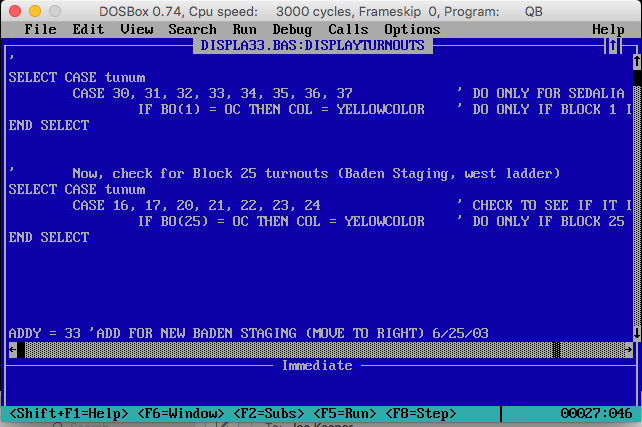
Today, I spent all day in the basement, working on the layout. I didn't build or paint rolling stock. I didn't work on scenery or track or ballasting. I didn't speed match or consist locomotives. I didn't install tortimusses or string yet another mile of wire beneath the layout.
I worked on the computer program the runs the layout.
All.
Day.
Long.
So, does that count as a day of "modeling"? To me it does! I worked on the dispatcher's screen, getting the staging ladder turnouts to show the occupancy state of the ladder blocks, so the dispatcher can easily see when a train is entering and leaving the staging yards. It may not seem like much to describe, but it really adds clarity to the dispatcher's screen, and, therefore, will (presumably) make life a bit easier for the dispatcher. That was the goal of the whole exercise, anyway. Along the way, I remove some extraneous code that is obsolete since the conversion to DCC a couple of years' back. The code removal will improve the loop cycle time a tiny bit, which is already at a satisfactory 12 cycles per second.
My ruminations tonight are centered on the primary appeal of this hobby to me, namely the variety of activities and interests that model railroading offers. Don't want to do scenery tonight? Fine, build or paint a car. Do some photography. Work on some operations paperwork. There are plenty of varied activities to keep a person engaged. When you add an electrical/computer/programming aspect to the mix, you have no cause to become bored with the hobby.
Now, I don't code much these days; the program that I use to run the Mighty MKT is mature and stable, and has been refined over the years. But I was able to dispatch the layout a bit during a recent operating session, and I noticed a few things that could use some improvement. So I spent the day in the coding chair making some new and some long-overdue tweaks and improvements. Working on the program has reminded me of the beauty and power of the Computer/Model Railroad Interface (C/MRI) - with just a few lines of code, you can add a feature or change a feature. Try that with a hard-wired system!
Having made these changes, I may not modify the program for several weeks or even months - like I said, it works pretty well. But it's nice to know that my coding chops are still decent.

Update on the Fiddle-Faddle train
Apr 16, 2016 Filed in: Work Night
I've received a couple of requests for more information about the Fiddle-faddle train mentioned in an earlier blog entry. During a recent track cleaning session, Dan used a couple of gravel hoppers and a Mighty MKT GP40 to deliver a little snack to Steve, who was cleaning loco wheels in the staging yard.
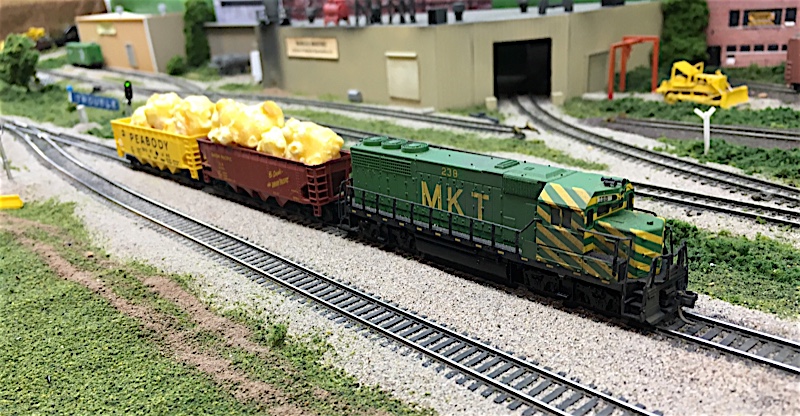



One thousand trees = a tiny hill
Apr 16, 2016 Filed in: Scenery
At my recent Thursday night work session, we made polyfiber trees. Oh, boy! did we make trees! Two solid hours of spray adhesive and dipping into ground foam. I had previously formed the polyfiber trees balls - I take a bag of fiber along with me while I railfan, and I pass the time between trains making the tree shapes.
At the end of the night, we had seemingly a thousand green tree balls (yes, there were plenty of 'ball' jokes that night). You would think that all those trees would be plenty to cover a vast expanse on the layout but, in reality, all those trees don't go as far as you might think.
So my advice to the prospective layout owner is: model the desert!!! Barring that, get starting making polyfiber trees!

Steve enjoys the fine fragrance of solvent-based adhesive
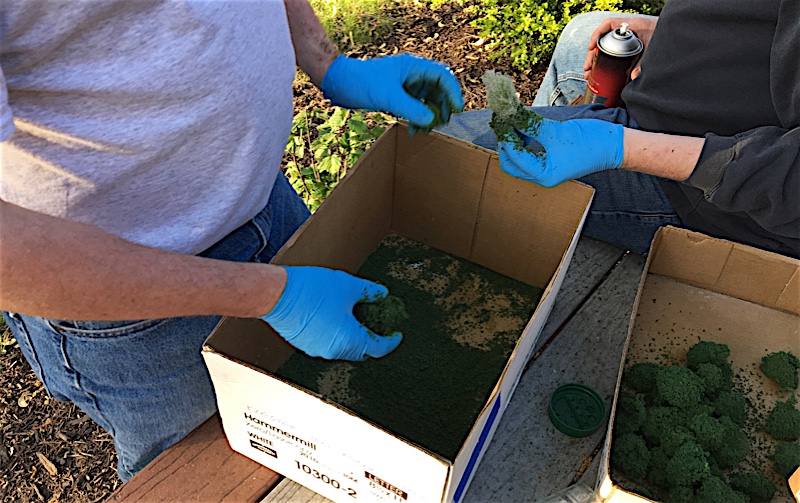
Teamwork is important as the sprayer hands off the proto-tree to the dipper
At the end of the night, we had seemingly a thousand green tree balls (yes, there were plenty of 'ball' jokes that night). You would think that all those trees would be plenty to cover a vast expanse on the layout but, in reality, all those trees don't go as far as you might think.
So my advice to the prospective layout owner is: model the desert!!! Barring that, get starting making polyfiber trees!

Steve enjoys the fine fragrance of solvent-based adhesive

Teamwork is important as the sprayer hands off the proto-tree to the dipper
The Components of a Scientifically Perfect Apology
Apr 16, 2016 Filed in: Ruminations
Often, simply saying “I’m sorry” isn’t enough. A decent apology should hit on multiple aspects of your wrongdoing. According to a recent study, there are six components you need to cover if you want to craft the perfect apology, and some are more important than others.

The study, led by Roy Lewicki, professor emeritus of management and human resources at The Ohio State University’s Fisher College of Business, and published in the journal Negotiation and Conflict Management Research, suggests that the most effective apologies contain these six elements:
The study also suggests that some of these elements actually carry more weight than the others. According to Lewicki, the most important element of an effective apology is acknowledging your responsibility. If something is your fault, say that it is. The second most important element, says Lewicki, is your offer of repair. If you say that you want to fix things, and explain how, your apology will go a lot further. The least effective element was the request for forgiveness. If there’s one things you leave out of your apology, make it that.

The study, led by Roy Lewicki, professor emeritus of management and human resources at The Ohio State University’s Fisher College of Business, and published in the journal Negotiation and Conflict Management Research, suggests that the most effective apologies contain these six elements:
- Expression of regret
- Explanation of what went wrong
- Acknowledgment of responsibility
- Declaration of repentance
- Offer of repair
- Request for forgiveness
The study also suggests that some of these elements actually carry more weight than the others. According to Lewicki, the most important element of an effective apology is acknowledging your responsibility. If something is your fault, say that it is. The second most important element, says Lewicki, is your offer of repair. If you say that you want to fix things, and explain how, your apology will go a lot further. The least effective element was the request for forgiveness. If there’s one things you leave out of your apology, make it that.
Great friends, great times
Apr 08, 2016 Filed in: Ruminations
I'm always grateful for my train friends. Modeling can tend to be a solitary endeavor - I've spent hours alone at the modeling bench or in front of the computer screening programming the C/MRI or working on the web sites. So an evening spent with like-minded friends is always a treat.
Tonight, Steven and Dan came over to help me with a couple of the least-enjoyable aspects of our hobby: cleaning wheels and cleaning track. I tend to consider this an ordeal, and enduring the process with friends made it almost enjoyable…almost.
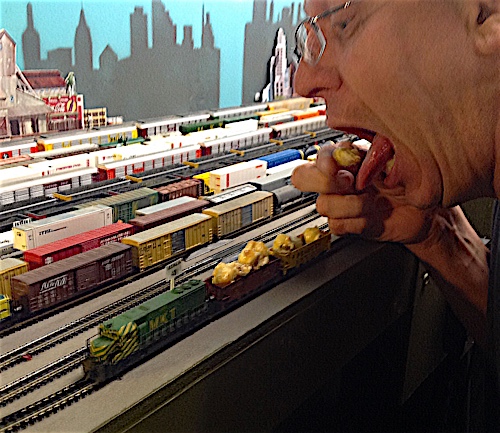
Stevie enjoys a snack from the "Fiddle-Faddle" train. The train provides snack commodities using "just in time" logistics.
Tonight, Steven and Dan came over to help me with a couple of the least-enjoyable aspects of our hobby: cleaning wheels and cleaning track. I tend to consider this an ordeal, and enduring the process with friends made it almost enjoyable…almost.

Stevie enjoys a snack from the "Fiddle-Faddle" train. The train provides snack commodities using "just in time" logistics.
Tavern Rock gets the Kasper Treatment!
Apr 05, 2016 Filed in: Track
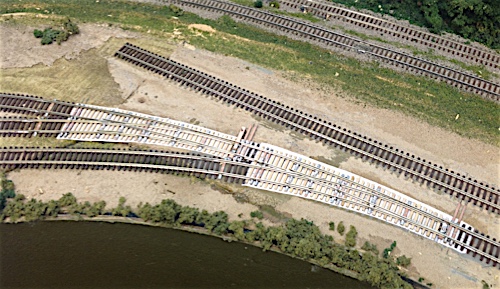
I am pleased to announce that all the local St. Charles industries are now fully retro-fitted with Kasper MK VII, Rev 2 turnouts, complete with tortimusses, diode matrix selection and rotary knob control panels.
Just another step in the gradual improvement of the layout. The St, Charles local should be a real treat to run from now on.
As usual, special thanks go out to Joe for his dogged installation in the face of nearly inaccessible locations and subpar working conditons. Joe, I owe you several more Long Island Iced Teas!

New lights for East Rhineland
Apr 02, 2016 Filed in: Scenery
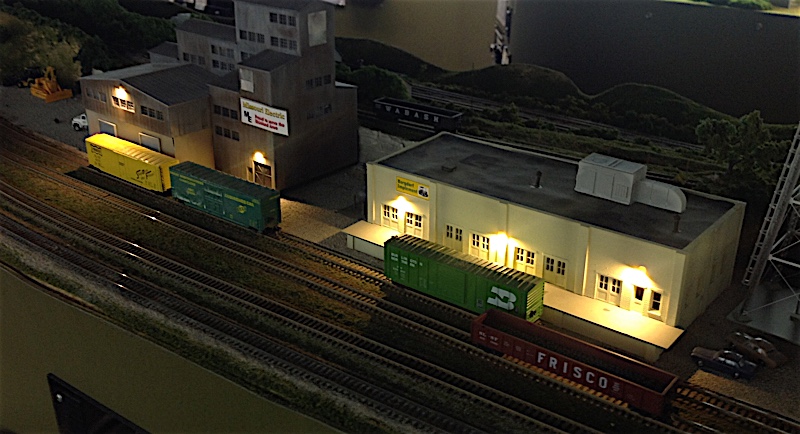
The upgrades continue, this time with some security lighting for the East Rhineland industries.
These are super bright, pre-wired, and tiny LEDs that are available on eBay.
New Panel for Tavern Rock
Apr 01, 2016 Filed in: Layout

Upgrading the turnouts at Tavern Rock Sand and Gravel has been on my list for a LOOONG time!
It's finally happening. Yes, the east end of St. Charles is getting the awesome Kasper MKVII, Rev 2 turnouts! And tortisuses. And a diode matrix. And a new panel.
As usual, special thanks to Joe for the turnouts (and the installation) and the clarification of the Captain America/Avengers story line.
Soon, all of manual throw turnouts in St. Charles will be eliminated - a long-awaited dream.